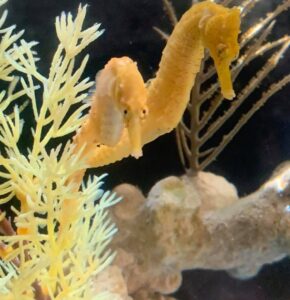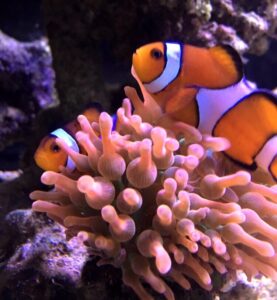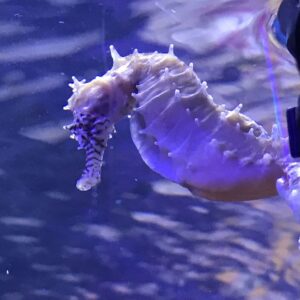A major part of keeping seahorses successfully has to do with feeding them properly and building up their immune systems. What to feed seahorses, how much to feed them, the different ways to feed them and how often to feed them are all important topics. In this article, we’ll cover the 3 main ways to feed seahorses.
Read More in articles Getting New Seahorses to Eat, Why Food is Key to Seahorse Success and What to Feed Seahorses.
Let's talk Methods
In this article, we’ll cover the 3 main ways to feed adult seahorses (excluding the lovely h.zostera, or “dwarf seahorses” that require live foods). If you prefer, you can watch the video!
Method 1: Broadcast feeding
Broadcast feeding is literally dropping the food into the tank (after a good rinsing to remove anything besides the mysis shrimp from the frozen cube) and letting the seahorses chase it to eat. I personally use adjustable wave makers and pumps in larger tanks, and adjustable HOB filters in smaller tanks, that allow me to turn down the flow in the tank while feeding. The seahorses still have to “chase the food”, but it’s not moving so fast that they can’t catch it.
The benefits to broadcast feeding include:
- Keeping seahorses active and in shape. When the seahorses have to “chase” the food that is being blown around, they are basically doing some daily exercises.
- Stubborn or new seahorses will be more attracted to moving food. Although WE know that they’re just getting frozen mysis, the movement of the food in the flow convinces the seahorses that they’re hunting live food.
The cons to this method include:
- Food can get trapped in the substrate, rocks, and other crevices leading to high organics.
- If you have any seahorses that are “picky eaters”, they might not get enough food
- If you have any other tank mates, the seahorses might be stressed out by competing for the food
Method 2: Target Feeding
Target feeding involves feeding the seahorses using a turkey baster, providing them one piece of food at a time. This method can become very labor intensive and is not typically necessary. I personally
The benefits to target feeding are:
- You know exactly how much the seahorse is eating at each feeding
- You never have to worry about food that you don’t see floating underneath a rock or decoration, that will lead to organics in the tank.
- You will know right away if the seahorse isn’t eating for any reason
The cons to this method include:
- It’s very time consuming to have to feed seahorses one piece of food at a time
- The seahorses aren’t getting any exercise
- Chances are….you don’t know how to do “tough love” (at least that’s what my mentors have told me, lol). I was okay with a seahorse feeding taking up more of my time to make sure that certain species were eating properly. Your seahorse tank is YOUR SEAHORSE TANK! So do what works for you! But, seahorses will eventually get hungry and eat….
Method 3: Dish or Feeder
Another feeding method is to use a dish or “feeder”. There are many different brands available and many people love to use them. But, just like the other methods, there are pros and cons to using a feeder that have to be considered.
The benefits to dish feeding:
- After training the seahorses to eat from a dish, it makes clean up much easier than broadcast feeding. Instead of the food going all over, it’s in one place. If the seahorses don’t eat it all, you can remove it easily from the same area
- Once the seahorses are trained to eat from the feeder, you’ll be able to physically see how much they are eating or if they are having any issues with eating
The cons to dish feeding:
- Every part of the feeding contraption has to be cleaned constantly. One of the biggest problems with keeping a seahorse tank clean is fogetting the places that aren’t seen. If your feeder has any type of tube that is used to carry the food down to the dish, it has to be taken apart with every water change and cleaned thoroughly. Any type of dish used also has to be cleaned constantly. If not, bacteria and organics will build up and cause problems.
- You have to TRAIN the seahorses to eat from the dish. Not a huge deal, but more work, when you could just throw the food in and call it a day.
Tips for Feeding New Seahorses
- Feed the seahorses as much as you think they might need on the first try
- Leave the area (new seahorses in a new tank do not want to see your face staring at them while they try to eat)
- After 10 minutes, look at the amount of food that is left in the tank
- Adjust the next feeding based on what you learned from the previous feeding. If the seahorses have eaten all the food and are still looking at you with wanton eyes…..you need to try a bigger feeding next time. If there is food still all over the tank and the seahorses are chilling on hitches….feed less.
- Keep playing with the amount you feed until you know that the seahorses in your tank can eat all of the food you provide within 10-15 minutes
- Provide this amount of food to them 3-4 times a day
- If your tank starts showing signs of buildup (like nuisance algae, detritus, or any other kind of problem, you should NOT stop feeding the seahorses adequately, but SHOULD either do more water changes or add more filtration to handle the higher bio load.
How Much Food to Feed Seahorses
How much food to feed depends on a lot of things – the size of the tank, the number of seahorses, your filtration set up, and your maintenance routine. Seahorses are messy eaters, that can overeat and not get enough nutrition from their food, because they push the food through their system too quickly. They also blow out masticated particles of food from their gills with every bite (no, I’m not kidding – watch the video!!!). But, figuring out how much to feed your current seahorse tank isn’t as difficult as it sounds!
Read more about feeding seahorses



